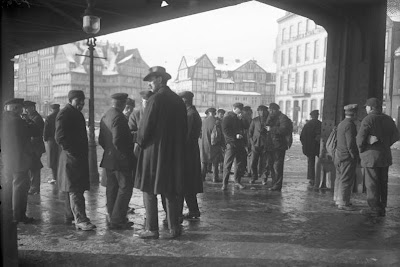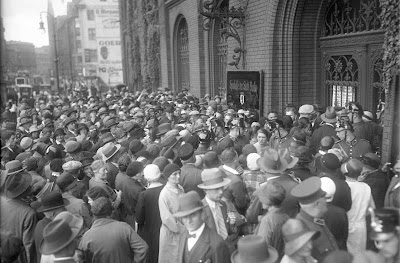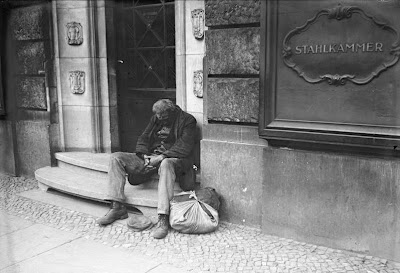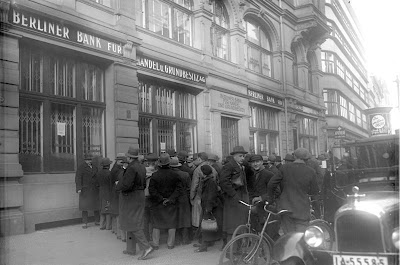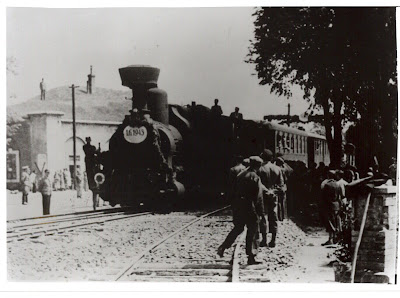The fourth weekend of January, Joshua and I went down to New York. The purpose of our visit was to catch three performances at New York City Ballet.
On Friday evening, January 21, the company danced George Balanchine’s “Walpurgisnacht Ballet”, Jerome Robbins’s “Dances At A Gathering” and Alexei Ratmansky’s “Concerto DSCH”.
“Walpurgisnacht Ballet” was created in 1975, at the invitation of Rolf Liebermann, for a new production of Gounod’s “Faust” at The Paris Opera (a now-famous production in which the opera was set during the time of the Franco-Prussian War). The ballet was to enter the repertory of New York City Ballet in 1980.
“Walpurgisnacht Ballet” was the second Balanchine ballet whose origins may be traced to Liebermann. In 1963, Liebermann had engaged Balanchine to create dances for a production of Gluck’s “Orpheo Ed Euridice” at the Hamburg Staatsoper. The Hamburg Gluck dances were to reemerge thirteen years later at New York City Ballet as “Chaconne”.
Despite its creation for a production of “Faust”, “Walpurgisnacht Ballet” is abstract; the choreographer made no attempt to depict the events called for by the opera’s scenario.
“Walpurgisnacht Ballet” has always reminded me of “Serenade” insofar as both ballets are purely abstract works yet highly suggestive of incident. Both ballets are gentle if not pastoral, yet neither lacks mystery or drama—and both sport a major climax at the end.
Both ballets are danced on a bare stage and involve the endless unfolding of complex geometric progressions. Both ballets require refined, virtuoso dancing. Purity of style is paramount: imperfection of
port de bras or
epaulement is glaring; the slightest overextension becomes a shocking event. I am surprised that “Walpurgisnacht Ballet” is not performed more frequently than it is, both by NYCB and other companies, since the ballet clearly is from Balanchine’s top drawer. I could easily watch the ballet a hundred times.
On January 21, when he saw the ballet for the first time, Josh said that he, too, could see countless elements of “Serenade” in “Walpurgisnacht Ballet”—and not simply because the cast requirements are similar (one male dancer and seventeen female dancers for “Serenade”; one male dancer and twenty-four female dancers for “Walpurgisnacht Ballet”). Both ballets, unmistakably from the hand of the same master, show Balanchine working in a state of grace.
The January 21 performance of “Walpurgisnacht Ballet” appeared under-rehearsed, most evident in the female principal and male principal, both of which were tentative in their roles. Balanchine’s ballet, nonetheless, was the highlight of the evening’s program.
I would be pleased to see Balanchine’s ballet performed within the context of an uncut presentation of the Gounod opera. Despite its restraint and cool tone, “Walpurgisnacht Ballet”, an example of purest Classicism, strikes me as perfect choreography for Gounod’s very objective and very French musical interpretation of Goethe’s masterwork.
My parents attended a performance of The Paris Opera production of “Faust” in 1976 during The Paris Opera’s visit to the United States as part of America’s Bicentennial celebrations. My parents recall that, for the U.S. tour, Balanchine’s ballet had been excised from “Faust” (probably because The Paris Opera Ballet had been left behind in Paris)—but they nonetheless recall the performance with special pleasure because that Paris Opera “Faust” provided them with their only opportunity to hear the great French tenor, Alain Vanzo. Other than those 1976 tour appearances with The Paris Opera, Vanzo never appeared in a fully-staged opera production in the United States.
My parents were not to catch “Walpurgisnacht Ballet” until the autumn of 1980, when they saw the ballet on the same evening that Darci Kistler, the last of the great ballerinas coached by Balanchine himself, made her professional debut—at the age of sixteen—in Balanchine’s one-act recension of “Swan Lake”.
Only days later, I was born.
The “Dances At A Gathering” that followed “Walpurgisnacht Ballet” operated on a much lower plane.
I have never been an admirer of Robbins’s “Dances At A Gathering”, and the performance of January 21 did not cause me to change my mind.
The ballet is too long—it lasts over an hour—and the ballet has a hopeless 1960s sensibility that I find unattractive. Of more importance, Robbins lacked the sheer genius of Balanchine when it came to creating dances for the dance.
Performed to Chopin, “Dances At A Gathering” features ten dancers, five male, five female, working singly or in groups of two to ten, put through a variety of maneuvers. There are suggestions of romance, and disappointment, and despair. Portions of the ballet are playful, portions of the ballet are mournful—but most of the ballet is uneventful. Twenty minutes of choreography have been stretched to occupy sixty minutes.
“Dances At A Gathering” has been staged by countless companies throughout the world since its 1969 premiere, so the ballet obviously has its adherents. Myself, I have never understood the ballet’s appeal.
Things are not helped by having to listen to eighteen Chopin pieces in succession. Two Chopin works at a time are more than enough for me—I hold the minority view that Chopin was a composer for the salon—and being forced to listen to Chopin for an hour is, for me, a chore if not an outright punishment.
Matters were made worse on January 21 by the fact that the pianist was not good—and the instrument in use featured a hard, brittle sound.
It was an unrewarding hour.
Balanchine’s ballets are timeless. An observer without background information would be unable to “place” Balanchine’s ballets. There is nothing of the 1970s in “Walpurgisnacht Ballet”, just as there is nothing of the 1930s in “Serenade” and nothing of the 1940s in “The Four Temperaments” or “Symphony In C”.
Robbins’s ballets, on the other hand, are pure artifacts of the times of their creations. “Dances At A Gathering” positively screams “1969”, just as “Interplay” heralds “1945” and “Glass Pieces” trumpets “1983”.
“Dances At A Gathering” would benefit from re-costuming. The 1960s color scheme is outdated and now looks garish if not ridiculous—and the costumes for the male dancers need to be totally rethought (and the boots retired).
The art of costuming at its zenith was not displayed in “Concerto DSCH”, either. The colors were not pleasing, the designs nowhere near the level of accomplishment routinely achieved by Madame Karinska for Balanchine during the master’s lifetime.
(Balanchine always demanded that his dancers be dressed—and lighted—to the highest standard. While Balanchine was alive, premieres of new ballets were sometimes delayed, at considerable expense, because Balanchine was not happy with the costuming. Sometimes at his request completed costumes were discarded entirely and new ones created, the most famous case being “Vienna Waltzes”. Shortly before the scheduled premiere in 1977, Balanchine decided that synthetic materials would not do, as they lacked the necessary “swoosh” for the ladies’ gowns. Consequently, he ordered Madame Karinska to remake all costumes for the female dancers from pure silk, at a cost of more than half a million dollars, a not insignificant sum at the time. Of course, the end result, seen onstage, is glorious.)
Josh and I had
attended a performance of Ratmansky’s “Concerto DSCH” in January 2009, just a few months after the ballet’s 2008 premiere, and we were eager to see the ballet a second time. Set to Shostakovich’s Piano Concerto No. 2, one of that composer’s most vapid and least successful scores, the ballet’s frivolous surface and gaiety are illusive—there are grim undercurrents beneath the surface.
When we saw “Concerto DSCH” two years ago, I believed the ballet was, in part, a comment on Stalinism.
The score guided me in that belief. Composed in 1957 as a birthday gift for the composer’s son, Maxim, who played the concerto worldwide over the following ten years, the Piano Concerto No. 2 may be interpreted as the composer’s sigh of relief over the end of Stalinism (all the while looking over his shoulder at the footprints left behind). The score’s deliberately banal surface scarcely concealed the composer’s frazzled nerve endings.
Having experienced “Concerto DSCH” a second time, I no longer see Stalinist associations in Ratmansky’s ballet. My earlier impressions were wrong, I believe. The ballet is, more likely, nothing more than the choreographer’s exploration of the fragility of human relationships. The ballet’s undercurrent of tension is an expression of human—not political—stress.
I thought I would see more in “Concerto DSCH” on second viewing than on first viewing. “Concerto DSCH” was, I thought, a ballet that would reveal more and more secrets with each successive encounter.
Once again, I was wrong. “Concerto DSCH” offered no more richness upon a second encounter than it had offered on first acquaintance. In fact, I liked the ballet less in 2011 than I had liked it in 2009.
“Concerto DSCH” was so unprepossessing on second viewing that I now believe it inferior to Kenneth MacMillan’s 1966 ballet, “Concerto”, danced to the same score—and MacMillan’s “Concerto”, despite a few attractive moments, is anything but a masterwork.
A great deal of energy is on display in “Concerto DSCH”, especially in the first and third movements, but ultimately the ballet does not amount to much.
A second viewing of “Concerto DSCH” revealed alarming parallels with the ballets of Robbins. Among other things, cast members not dancing remained onstage, observing the work of their fellow cast members (a longstanding—and irritating—Robbins
tic). The Robbins parallels did not redound to the benefit of “Concerto DSCH”.
Of greater concern, portions of “Concerto DSCH” are borrowed from Maurice Bejart. The opening of the ballet—a female dancer emerging from a circle composed of other dancers—is one of the most tiresome devices of the 1960s and one of the most tiresome devices of Bejart. I am surprised that the choreographer had the face to use such a stale gesture in 2008 (and I am, further, surprised that New York dance reviewers did not bother to mention use of this particular Bejart cliché in their worshipful reviews of “Concerto DSCH” at the time of the ballet’s premiere).
It is not unusual for ballet lovers to change their opinions of a ballet upon repeated viewings. As a general rule, the greater the choreography, the more the ballet lover likes a work over time—and the worse the choreography, the less the ballet lover likes a work over time.
My interest in Ratmansky’s work took a serious nosedive after my second look at “Concerto DSCH”.
It is an over-praised, and not particularly good, ballet—and I am not interested in seeing “Concerto DSCH” again anytime soon.
